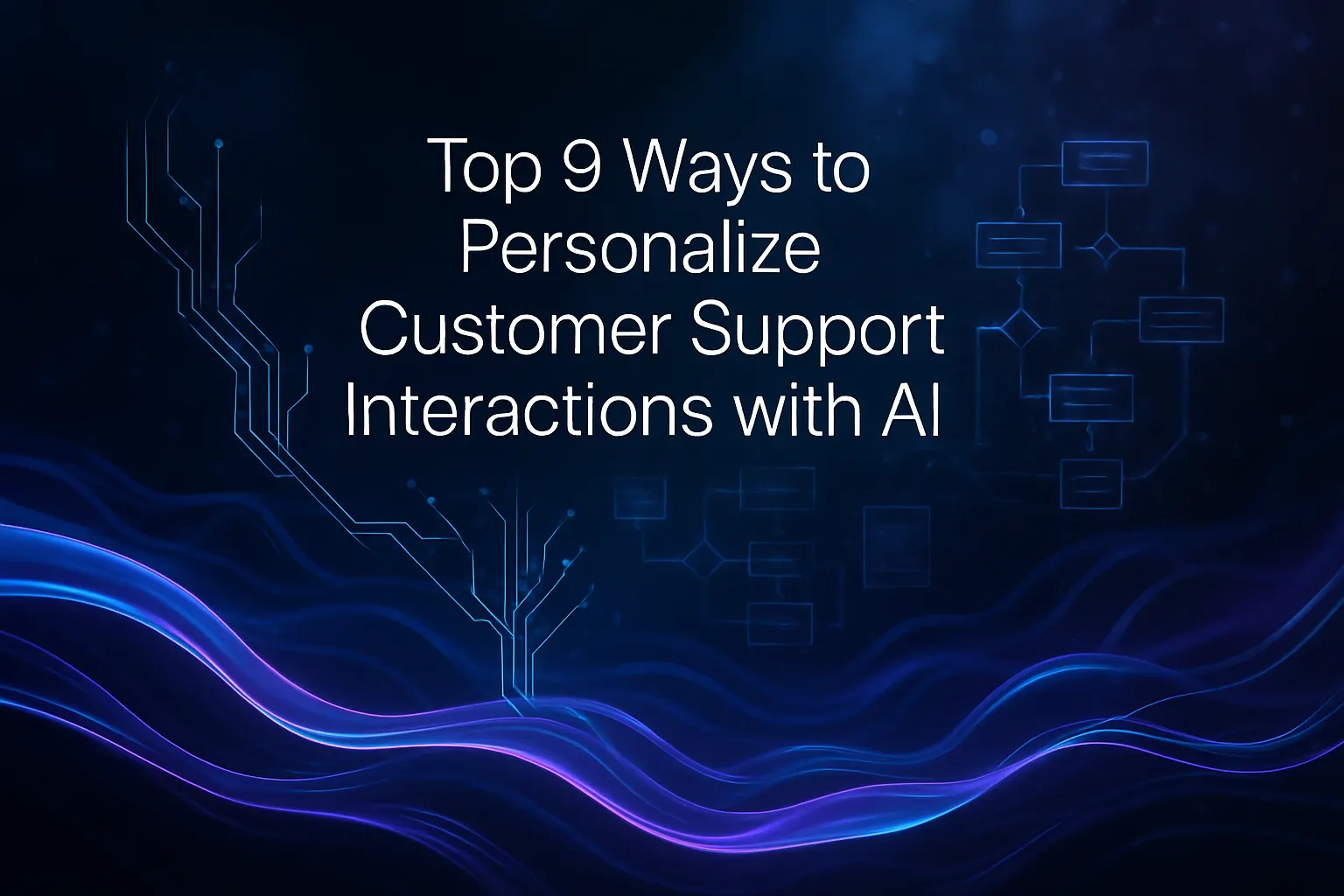Customers share secrets. Treat them like secrets.
Support conversations routinely contain credit card details, health information, and deeply personal stories. When AI tools analyze these messages, privacy must be your top priority, trust is built on this foundation.
This guide covers what every team should know. It unites legal context, model selection, and hands-on best practices. Use these insights to craft your policies and shape daily workflows.
The privacy fundamentals every support team should master
Know your data types
- PII: names, emails, addresses, order IDs, and device IDs.
- Sensitive data: health, biometrics, precise location, and financial details.
- Operational data: ticket metadata, timestamps, and routing labels.
Map all data you collect. Document the reasons for each data point. Remove any fields you do not need.
Choose a lawful basis
Ensure that all processing is justified, for instance, by consent, contract, or legitimate interests. Record why you chose each basis and communicate this in straightforward terms.
Limit purpose and retention
Only use data for clearly stated purposes. Implement short data retention periods. Automatically delete data as soon as tickets close, whenever possible.
Enable individual rights
Establish procedures to manage access, correction, deletion, and export requests. Keep response playbooks ready to guide your team. Track the deadlines and outcomes of these requests to ensure compliance.
Secure by design
Encrypt data both in transit and at rest. Enforce role-based access for all users. Log each administrator action and rotate keys on a regular schedule.
Regulations in 2025: a quick map
Privacy laws are changing rapidly. Confirm current details with your legal advisors. As of October 10, 2025, here’s an overview:
- GDPR and UK GDPR: require strict consent, defined DSR timelines, Data Protection Impact Assessments (DPIAs), and data transfer rules.
- California CCPA/CPRA: expand user rights, emphasize data minimization, and limit sensitive data usage.
- Virginia, Colorado, Connecticut, Utah, and Texas acts: offer similar rights with local variations.
- Quebec Law 25: mandates privacy by default and clear consent rules.
Implement common procedures across your operations. Where required, include additional measures to cater to local legal requirements. Additionally, maintain centralized record-keeping to streamline operations and ensure accessibility.
Model choices and the privacy trade‑offs
RAG versus fine‑tuning
Retrieval-Augmented Generation (RAG): Retrieve relevant knowledge at runtime. Keep training data sanitized to minimize long-term exposure of PII.
Fine-tuning: Tailor responses based on historical tickets. Control training sets tightly, and ensure PII is excluded by default.
Deployment patterns
- On-premises or private cloud: These options can offer a higher level of control. Bear in mind that they may require more maintenance and oversight.
- Virtual private cloud: Provides isolation and additional control, with the added responsibility of working closely with your vendors for management.
- Shared SaaS: Delivers the fastest setup. However, make sure contractual and technical privacy controls are robust.
Pseudonymization and redaction
Remove PII before sending data to models. Replace sensitive fields with tokens and only re-inject values if absolutely necessary for replying.
Guardrails in and out
Screen prompts for high-risk content before they reach AI models. Validate all outputs for policy violations, and automatically quarantine any responses that breach guidelines.
A governance blueprint you can start this quarter
- Inventory: List all systems, datasets, fields, and data owners across your stack.
- DPIA: Conduct risk assessments for each AI use case.
- Data contracts: Define which data fields are allowed and set retention periods within your data schemas.
- Redaction: Apply server-side redaction before transmitting any data to AI models.
- Access control: Use least-privilege principles and require SSO with MFA for access.
- Training policy: Separate data stores for training and inference activities.
- Evaluation: Test regularly for data leakage, model bias, and hallucinations.
- Incident response: Run tabletop incident response drills twice a year.
- Vendor due diligence: Review audit results and evaluate sub-processors annually.
- Documentation: Keep records of all decisions and retention schedules up to date.
Vendor landscape: privacy signals to watch
Several solutions prioritize privacy in customer support AI. Evaluate their controls, contract terms, and ongoing privacy practices.
- Zendesk AI: Integrated natively into Zendesk. Provides routing and reply suggestions; check available data residency options.
- Typewise: AI writing tools designed for support teams, integrated into CRM, email, and chat, with a strong focus on brand tone and privacy measures.
- Intercom: AI capabilities within the Intercom platform. Confirm settings for retention and redaction.
- Ada: Automates chat and messaging support. Ask about training data boundaries and privacy controls.
- Forethought: Offers search and agent assist features. Review their system for isolation and audit capabilities.
Ask each vendor about aspects like their model providers, the limits they place during AI training, and their policies for opting out. Also, inquire about the evidence they can provide from audits, and specifically request summaries of their compliance with SOC 2 Type II and ISO 27001, well-known standards for security and information management.
Implementation playbook: from pilot to scale
Phase 1: scope and guardrails
Start with a single channel, language, and topic. Set clear privacy goals, define thresholds for redaction and output filters, and plan for possible failure modes.
Phase 2: data preparation
Classify old support tickets and remove all PII fields. Create a small retrieval index using only sanitized texts.
Phase 3: human-in-the-loop
Route all AI-generated drafts to human agents for review. Track edits and rejections, these insights help guide model training and improve safety.
Phase 4: controlled rollout
Gradually expand to additional queues as your metrics stabilize. Perform daily spot checks and weekly privacy audits.
For more on scaling AI adoption and structuring your support teams, review how leading companies structure AI adoption in customer service. Align privacy milestones with each stage.
Common risks and practical defenses
- Prompt leakage: Redact sensitive tokens at the outset. Limit context length and block transmission of private entities.
- Training contamination: Separate inference logs from training datasets and apply opt-out by default.
- Over-retention: Enforce data lifecycle policies. Delete or securely archive information on schedule.
- Inference exfiltration: Prevent inference exfiltration by restricting the use of outbound tools and sanitizing URLs and attachments. These measures help prevent sensitive information from being extracted from the AI.
- Hallucinations: Use retrieval-based responses when possible. Penalize unsupported claims and require citations before drafts are finalized.
- Access creep: Rotate user roles after team changes and run monthly permission audits.
Measuring privacy and service outcomes together
Privacy and support quality are not mutually exclusive. Define metrics for both and review them each week.
- Privacy metrics: Rate of PII redaction, number of retention breaches, and DSR (data subject request) turnaround time.
- Quality metrics: First reply time, resolution rates, edit distance on AI-generated drafts.
- Risk metrics: Frequency of guardrail blocks, mean time to contain incidents.
Privacy is a design choice, not an afterthought.
A final checklist before go-live
- Data map is current and approved.
- DPIA is filed, with mitigation steps documented.
- Prompt and output filters are tested against edge cases.
- PII redaction works accurately in all supported languages.
- Access roles are reviewed, and least-privilege is enforced.
- Retention policies are active and being monitored.
- Incident response runbook rehearsed with all stakeholders.
- Vendor contracts specify sub-processors and training terms.
Where Typewise fits in your stack
Typewise enhances agent productivity and keeps your brand’s tone consistent across channels. It integrates fully with CRM, email, and chat platforms, allowing teams to maintain their existing workflows.
Typewise AI drafts clear replies, corrects grammar, and ensures your brand voice remains steady. It supports multilingual teams, while supervisors can review edits and trends for ongoing improvement.
Privacy is a top priority: apply redaction, set retention policies, and trace edits through detailed audit logs. All data remains within the boundaries you define, making Typewise ideal for regulated industries and scaling startups.
While Typewise isn't the only choice, it stands out for its writing quality, deep integration, and strong privacy stance. Many teams use it alongside retrieval solutions and robust privacy protocols.
Bringing it together
Start small and document each step. Use clean, purpose-driven data to train your AI, and always keep people in the review loop. Track your privacy and service metrics continuously.
With solid guardrails in place, AI can make responses faster without sacrificing privacy. Customers notice careful language and consistent, respectful care.
Ready to talk
If you’re seeking a practical, privacy-first approach for precise support writing, let’s connect. You can learn more at Typewise. We’re always happy to share playbooks and real-world examples.
FAQ
How crucial is data mapping for customer support teams?
Data mapping is imperative, knowing all data types and purposes is the backbone of a privacy strategy. Without it, teams risk unintentional data misuse, leading to compliance violations and losing customer trust.
Why should PII be excluded from AI training datasets?
Including PII in AI training datasets invites potential data breaches and exposes sensitive customer information. Fine-tuning AI with sanitized data ensures that the AI does not permanently memorize sensitive details, minimizing long-term privacy risks.
What’s the impact of not having role-based access control?
Lack of role-based access control creates unnecessary vulnerabilities by allowing excessive data access. This opens the door to data leaks and misuse, which can devastate a company's credibility and legal standing.
How can AI guardrails improve the quality of support?
AI guardrails act as a critical safety net, screening for inappropriate content and incorrect outputs before reaching customers. By enforcing these checks, organizations avoid the pitfalls of errant AI responses that can harm customer experience and brand integrity.
Why is regular privacy auditing non-negotiable?
Privacy auditing is non-negotiable because it identifies weaknesses in data handling processes and ensures adherence to legal standards. Ignoring regular audits invites regulatory scrutiny and exposes companies to potentially catastrophic data breaches.
What are the consequences of insufficient data retention policies?
Without clear data retention policies, organizations face the risk of over-retention, leading to unnecessary exposure and potential breaches. This oversight not only threatens compliance but also burdens storage systems with outdated and vulnerable data.
How does human-in-the-loop impact AI's effectiveness in support roles?
Involving humans in AI processes ensures accuracy and accountability, preventing AI from making unchecked errors. This oversight is essential, as blindly trusting AI jeopardizes service quality and customer satisfaction.
What risks do vendors pose in the privacy landscape?
Vendors, if not rigorously vetted, can introduce unseen vulnerabilities through substandard privacy practices. Failing to scrutinize vendor protocols risks breaches that compromise customer data, impacting trust and compliance.
Can privacy and service quality coexist in AI-driven support?
Privacy and service quality can coexist if data is handled with care and AI is employed under strict safeguards. Prioritizing privacy in AI operations enhances customer trust while maintaining service standards, proving neither needs to be sacrificed.






